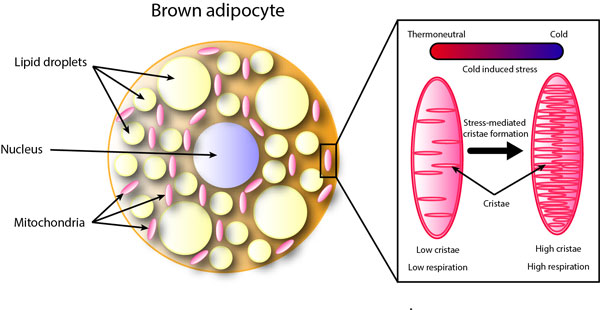Mitochondria are cellular organelles that perform cellular respiration. They consist of two distinct membranes (outer and inner) that maintain mitochondrial morphology and structure. Inside mitochondria, the inner membrane forms invaginations known as cristae, very specialized structures that support respiration. Cristae formation is possible through the Mitochondrial Contact Site and Cristae Organizing System (MICOS) protein complex, which provides spatial cristae distribution and architecture. When cells or tissues are exposed to stress conditions, increases in cristae density and respiration are required to satisfy cellular energetic demands. However, the mechanisms controlling cristae formation upstream of the MICOS complex were completely unknown.

Figure: Graphical representation of brown adipocytes and cristae biogenesis upon cold exposure.
Brown adipocytes are very specialized cells and highly enriched in mitochondria. These cells initiate a thermogenic program upon cold exposure that promotes fatty acid utilization to generate heat and maintain body temperature. Brown adipocytes undergo very dynamic remodelling of mitochondrial cristae, increasing density upon cold stimulation and provide a model to study cristae biogenesis. Importantly, disturbances in brown adipose tissue function negatively impact mitochondria abundance resulting in obesity and diabetes.
HFSP fellow Pedro Latorre-Muro and colleagues have found how brown adipocytes adapt during cold stress and increase cristae density and cellular respiration. The mechanism requires activation of the endoplasmic reticulum, an organelle that senses stress, which signals to mitochondria and increases the import of essential MICOS components to induce cristae formation and promote respiration. Since ER-mitochondria interactions sustain cellular homeostasis in every tissue, these findings may have implications in processes including obesity, diabetes or age-related diseases where ER-mitochondria communication is disrupted and cellular respiration impaired.


































